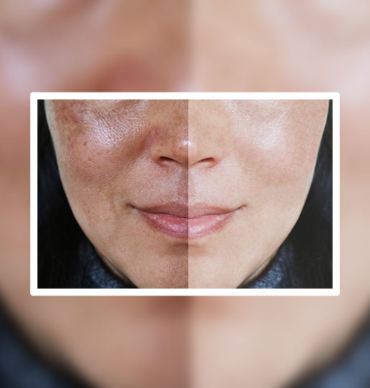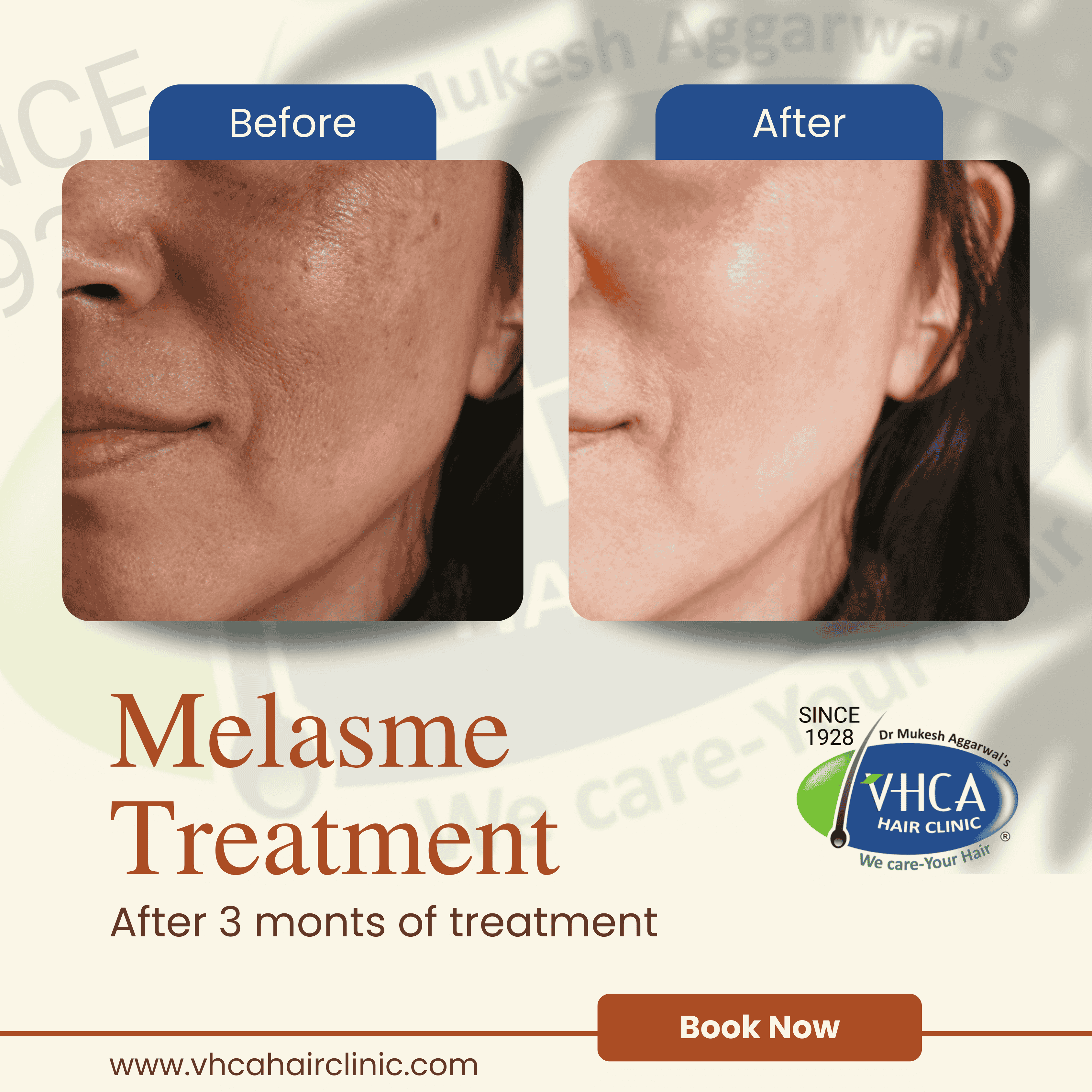Since 1928VHCA Hair Clinic World's 1st Ayurveda Hair Clinic
Melasma
Melasma is a common skin condition characterized by dark, discolored patches on the skin, primarily affecting the face. It is more prevalent among women, particularly those with darker skin tones. The condition is triggered by various factors, including sun exposure, hormonal changes (such as during pregnancy or with the use of birth control pills), and certain medications. The brown or gray-brown patches typically appear on the cheeks, forehead, bridge of the nose, chin, and above the upper lip, but can also occur on other sun-exposed areas.

Causes of Melasma
Sun Exposure: Ultraviolet (UV) light from the sun stimulates melanocytes (the skin cells that produce pigment), leading to the darkening of melasma patches. Even minimal sun exposure can cause melasma to return after treatment.
Hormonal Changes: Hormonal fluctuations, especially during pregnancy, can trigger melasma. This is why melasma is often referred to as the "mask of pregnancy." The use of oral contraceptives or hormone replacement therapy can also contribute to the development of melasma.
Genetics: A family history of melasma increases the likelihood of developing the condition. Individuals with a genetic predisposition are more prone to melasma when exposed to the triggering factors.
Medications and Products: Certain medications, particularly those that make the skin more sensitive to sunlight, can contribute to melasma. Additionally, some skincare products may irritate the skin, making melasma worse.
Symptoms of Melasma
Melasma primarily manifests as dark, discolored patches on the skin. These patches can vary in size and are most commonly found on sun-exposed areas of the face. The symptoms include:
Brown or Gray-Brown Patches: The most recognizable symptom of melasma is the appearance of brown or gray-brown patches on the skin. These patches usually have an irregular shape and are darker than the surrounding skin.
Facial Distribution:
Cheeks: Melasma often appears symmetrically on both cheeks, creating a butterfly-like pattern.
Forehead: Dark patches may develop across the forehead, often extending down the temples.
Nose: The bridge of the nose is a common area for melasma patches.
Upper Lip: A darkened area above the upper lip is another characteristic sign of melasma.
Chin: The chin area may also be affected by melasma, contributing to an overall uneven skin tone.
Sun-Exposed Areas: While melasma is most commonly seen on the face, it can also occur on other sun-exposed areas of the body, such as the neck and forearms.
Gradual Onset: Melasma typically develops gradually over time, often becoming more pronounced with increased sun exposure or hormonal changes.
Asymptomatic: Melasma does not cause any physical discomfort, such as itching or pain. The condition is purely cosmetic, although it can lead to significant emotional distress due to its impact on appearance.
Symmetrical Appearance: One of the distinguishing features of melasma is its symmetrical appearance, meaning the patches often mirror each other on both sides of the face.
Symptoms of Melasma
Melasma primarily manifests as dark, discolored patches on the skin. These patches can vary in size and are most commonly found on sun-exposed areas of the face. The symptoms include:
Brown or Gray-Brown Patches: The most recognizable symptom of melasma is the appearance of brown or gray-brown patches on the skin. These patches usually have an irregular shape and are darker than the surrounding skin.
Facial Distribution:
Cheeks: Melasma often appears symmetrically on both cheeks, creating a butterfly-like pattern.
Forehead: Dark patches may develop across the forehead, often extending down the temples.
Nose: The bridge of the nose is a common area for melasma patches.
Upper Lip: A darkened area above the upper lip is another characteristic sign of melasma.
Chin: The chin area may also be affected by melasma, contributing to an overall uneven skin tone.
Sun-Exposed Areas: While melasma is most commonly seen on the face, it can also occur on other sun-exposed areas of the body, such as the neck and forearms.
Gradual Onset: Melasma typically develops gradually over time, often becoming more pronounced with increased sun exposure or hormonal changes.
Asymptomatic: Melasma does not cause any physical discomfort, such as itching or pain. The condition is purely cosmetic, although it can lead to significant emotional distress due to its impact on appearance.
Symmetrical Appearance: One of the distinguishing features of melasma is its symmetrical appearance, meaning the patches often mirror each other on both sides of the face.
Ayurveda Perspective on Melasma
In Ayurveda, melasma is understood as a result of an imbalance in the body's doshas, primarily Pitta dosha. Pitta represents heat and is responsible for metabolism, digestion, and transformation. When aggravated, Pitta can cause excessive heat and toxins (Ama) to accumulate in the body, leading to hyperpigmentation issues like melasma. Ayurveda offers a holistic approach to treating melasma by balancing the doshas, detoxifying the body, and promoting natural healing.
Ayurvedic Treatment for Melasma
Herbal Remedies:
Kumkumadi Oil: This traditional VHCA Ayurvedic oil, made from a blend of saffron, sandalwood, and other herbs, is known for its skin-brightening and anti-pigmentation properties. Regular application can help reduce melasma patches.
Raktshodhak Syrup: An excellent blood purifier, helps detoxify the skin and reduce pigmentation.
Aloe Vera: Known for its cooling and healing properties, Aloe Vera can soothe the skin and lighten melasma patches.
Dietary Adjustments:
Cooling Foods: Incorporate cooling foods like cucumber, watermelon, and coconut water to pacify the Pitta dosha.
Avoid Spicy and Oily Foods: These can aggravate Pitta and worsen melasma.
Detoxification: Regular detoxification of the liver and blood can help reduce the appearance of melasma.
Lifestyle Modifications:
Sun Protection: Avoid excessive sun exposure and use natural sunscreens like VHCA sunscreen lotion.
Stress Management: Practice stress-reducing techniques such as yoga and meditation to prevent hormonal imbalances.
Hydration: Stay well-hydrated to maintain skin health and prevent the aggravation of melasma.
External Treatments:
Face Packs: Ayurvedic face packs made with turmeric, sandalwood, and rose water can help lighten pigmentation and improve skin texture.
Gentle Exfoliation: Regular exfoliation with natural ingredients like oats or chickpea flour can help remove dead skin cells and reduce the appearance of melasma.

Why Choose VHCA Ayurvedic Hair Clinic for Melasma Treatment?
At VHCA Ayurveda Hair Clinic, we understand that each individual's skin is unique. Our personalized approach to treating melasma involves a thorough assessment of your skin type, lifestyle, and underlying health conditions. Our treatments are designed to address the root cause of melasma, ensuring long-lasting results without harsh chemicals or invasive procedures.
Our expert practitioners combine traditional Ayurveda wisdom with modern dermatological knowledge to offer safe and effective solutions for melasma. Whether you're dealing with mild discoloration or more extensive pigmentation, VHCA Ayurveda Hair Clinic provides a holistic treatment plan tailored to your needs.
Connect for wellness: Begin Your Journey Today
